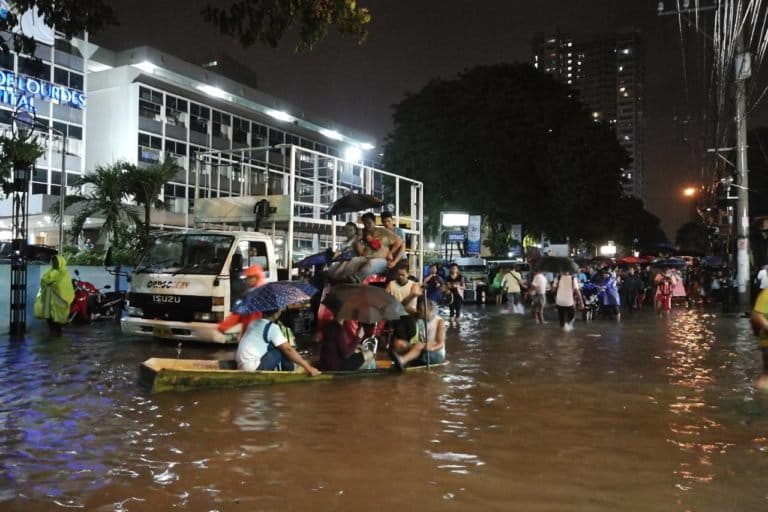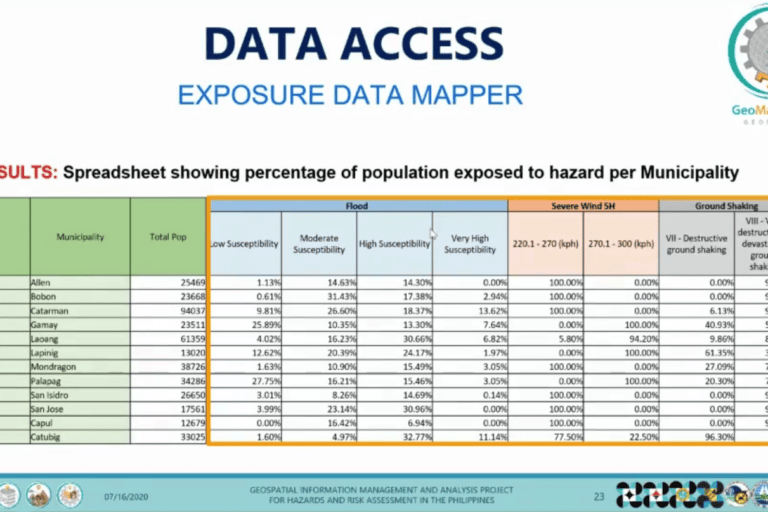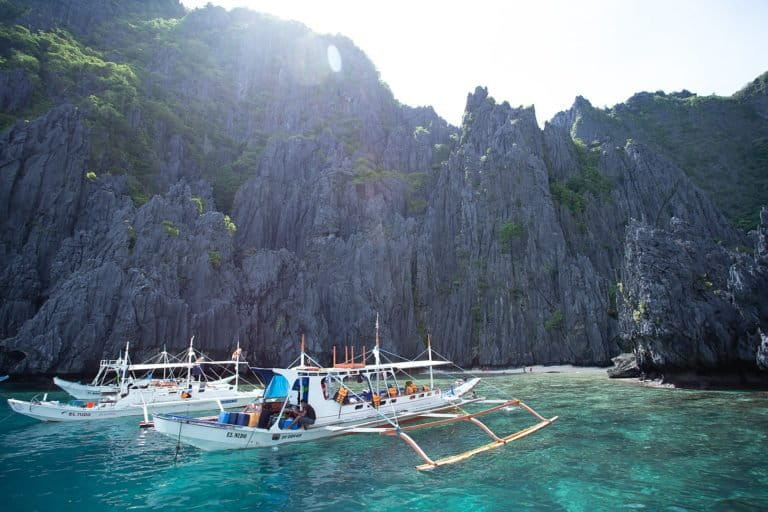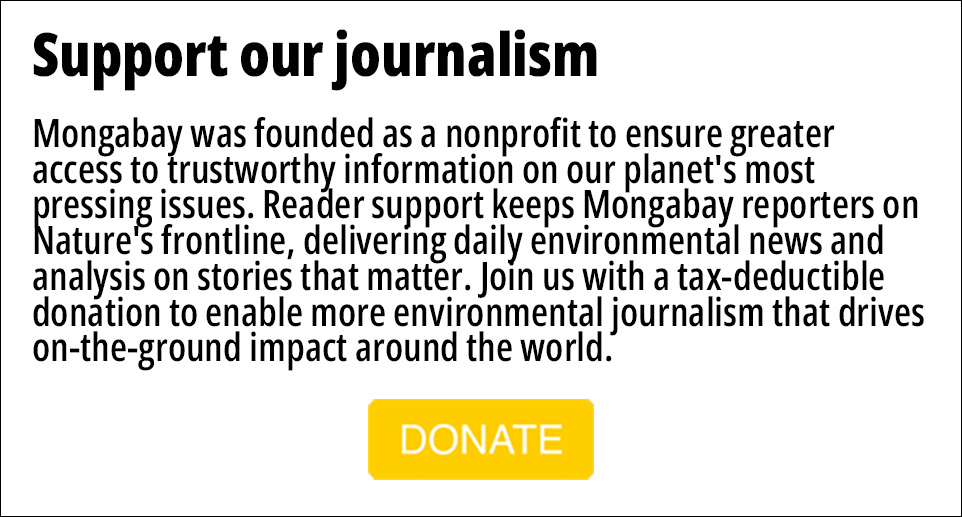Calamits Crew Rides Again How to Get Out
- The Philippines is among the topmost vulnerable countries in the world to natural disasters and climate impacts.
- Last yr, the country experienced a volcanic eruption, a series of major earthquakes, and successive typhoons that inundated more than 60 towns and cities.
- Knowing the country'due south vulnerability level to disasters, various government agencies rolled out a series of apps to assistance local authorities officials in crafting local solutions to these disasters.
- These solutions are based on the National Exposure Database (NED), a platform that collates data to aid in policymaking.
MANILA — For the Philippines, the COVID-xix pandemic wasn't the just disaster to hit the land in 2020. The year started out with a volcanic eruption and closed with two magnitude half-dozen earthquakes, one of them hitting on Christmas morning. In between came Draft Goni, a late-flavor superstorm that was the strongest in the world last yr.
At to the lowest degree 60% of the land's total land area, nearly 300,000 square kilometers (116,000 foursquare miles), is vulnerable to natural hazards, in large part due to the archipelago's location along both the path of the tropical storms brewing in the western Pacific and the Ring of Fire.
Around 74% of its population of more than 100 one thousand thousand is subject to various impacts from these disasters, and the land routinely ranks amongst the top x natural disaster-prone countries in the globe, according to the World Risk Index.

Mitigation efforts depend on a network of early-warning systems that are constantly existence fine-tuned, and on establishing mechanisms to respond more quickly to natural disasters.
The latest shot of help comes from the National Exposure Database (NED), which identifies vulnerable areas so agencies and local governments tin come with real-time analyses and craft swift responses during a disaster. It besides helps in planning and implementing disaster-prepare solutions.
Gathering the data …
The NED's primary tool for data collection and updates is GeoMapperPH, a web and mobile awarding that collates hazard, exposure, vulnerability, and coping capacity information from across the country. Launched last July, GeoMapperPH was developed by various regime agencies led by the Philippine Establish of Volcanology and Seismology (PHIVOLCS).
Congenital effectually a geographic information organization (GIS) core, information technology aids in disaster prevention and mitigation by borer the databases of at least 53 municipal governments, six national government agencies, and three NGOs.
Users, limited for at present to authorities entities and accredited NGOs, can input information in real-time, and access the information of other users to get a more comprehensive analysis of disaster-related concerns relative to their location.
Field surveyors can utilise the application offline and sync their data to the organisation once they're online.

By feeding in data such as edifice location, construction, and vulnerability, and combining it with data input from the national volcano and weather bureaus, the arrangement can generate automatic identification of natural hazard susceptibility. This enables local officials to see what percentage of the population would be exposed to ground shaking, severe current of air, or flooding in any given municipality.
Such exposure data are key in disaster response, rehabilitation, zoning and planning. Knowing natural hazard susceptibility in neighboring areas would also help in disaster direction. Additional inputs come in the form of automatically generated geocodes from data of the Philippine Statistics Authority and automatic identification of elevation and altitude from the declension using data from the National Mapping and Resource Data Authority'south interferometric constructed aperture radar.
… And putting it to use!
In terms of disaster preparedness, local governments tin can employ GeoMapperPH to create evacuation routes, develop evacuation centers, and situate public facilities far from danger-prone areas.
The GIS-based tool, known as "GeoMapperPH: Situation Data Mapper," is especially critical during the onslaught of a natural disaster. It monitors the state of affairs on the ground during calamities and feeds an awareness information dashboard that tin can be used for a more accurate bear on cess in a specified area.

The dashboard was in employ during the eruption of the Taal volcano at the start of 2020. It showed the affected population per city or municipality and estimated the cost of damage to agronomics of at least 3.21 billion pesos ($66 1000000). Knowing exact figures, such as the number of afflicted families currently in evacuation centers, puts a confront to the data and aids in prioritizing help for more devastated areas.
As for disaster rehabilitation and recovery, local governments are able to determine on the disbursements for affected areas based on the fiscal impacts of the disaster as indicated in the NED and determined with the help of GeoMapperPH.
Not just a planning tool
Although GeoMapperPH was created primarily for disaster management, it tin can be used for a much wider range of applications associated with geolocation, said Renato Solidum Jr., undersecretary of the Department of Science and Applied science and head of PHIVOLCS, the volcano bureau.
"GeoMapperPH is a tool to capture data, non only location, just other relevant information so that this can exist integrated into a platform," he told Mongabay.
The geospatial database created by GeoMapperPH is powerful because the location points tin can feature non only quantitative details similar measurements of areas and perimeters, but as well qualitative information like the historic period of a structure, building materials, blazon of basis soil, population, and and then on, Solidum said.
"Essentially, the geospatial data is crucial to whatever planning effort, monitoring, or bear on assessment whether information technology exist for disasters or environmental purposes or even for economical planning," he said.

Some examples of how GeoMapperPH tin be used, he said, including as a monitoring tool to bank check on the status of a tree-planting initiative or to look into areas with pollution as captured past satellite images.
"The traditional way of looking at data or statistics is past the table. But now, the tendency is for every indicate on the footing, yous can put whatsoever statistical data relative to that bespeak," Solidum said.
The GeoMapperPH team guides the platform'southward users by providing orientation classes, training, and consultations. Authorities agencies, local authorities, and NGOs tin also asking aid with database analytics equally well as the personalization of dashboards depending on their needs.
Other GeoMapperPH users include the Office of Ceremonious Defense, Rapid Earthquake Damage Cess System of PHIVOLCS, School Locator of the Section of Educational activity, and Health Facility Mapper of the Department of Wellness.
Mapping the Globe to salve it
The Department of Environment and Natural Resources has its own GIS already. Solidum said information technology was amongst the first authorities agencies to reach out to him regarding the use of GeoMapperPH for climate information services.
PHIVOLCS senior science inquiry specialist Mabelline Cahulogan told Mongabay that GeoMapperPH can also exist used to support ecology protection efforts.

"GeoMapperPH may assistance with proper environmental resource allocation and deployment," she said, adding that "proper easement from bodies of h2o may be determined and visually, conclusion-makers may pin downwardly areas that demand to exist cleared and areas that may still be inhabited."
Moreover, using the GeoMapper to build on the NED can contribute greatly to the decision-making process on sustainable development. Co-ordinate to Cahulogan, the NED would aid ensure that physical framework plans, comprehensive land use plans, and other disaster-related policies tin can exist formulated more efficiently.
In terms of land utilise and edifice use, there would be greater ease of doing business and increased transparency due to the information sharing enabled in the awarding.
The need for good governance
GeoMapperPH is role of the Geospatial Data Management and Analysis Project for Hazards and Risk Assessment in the Philippines (GeoRiskPH).
Established in 2018, GeoRiskPH includes ii publicly available platforms: HazardHunterPH for location-specific initial hazard assessments, and GeoAnalyticsPH for summaries of chance and adventure assessments, analysis, and visualization.
Thanks to the GeoRiskPH initiative, PHIVOLCS received the Special Achievement in GIS (SAG) Award in 2020 from Esri, the programmer behind the ArcGIS mapping platform that undergirds GeoRiskPH.

For Solidum, the rollout of the three GeoRiskPH applications is not just due to the technical expertise and dedication of the individuals involved in the initiative. "We take to empathise that the solution to a particular problem is not only technology," he said. "The tool is the technology, but governance would now enter the picture because the data and engineering are there, merely to convince organizations to engage is a different thing."
He pointed to the problem of hierarchy experienced in all countries and said his team had surmounted it by gaining the government'due south support. "If y'all don't take skillful governance, and so it will fail," he said.
Regional utilise of geospatial tech
While the rollouts and operations of GeoMapperPH, HazardHunterPH, and GeoAnalyticsPH have been smoothen sailing, the GeoRiskPH team is yet at work because the applications are ever-evolving platforms. The work doesn't cease one time data is encoded and a visualization map is generated because things can change overnight or in an instant.
And with his easily full due to the electric current developments and improvements in the GeoRiskPH platforms, Solidum said he aims for greater location intelligence efforts in the Philippines.

The GeoMapperPH squad is looking to incrementally scale upwardly the involvement of other government agencies, local governments, and NGOs in the initiative. Solidum said his team has been working to this end with the Department of Public Works and Highways.
The Philippines is looking to espouse location intelligence internationally by sharing its all-time practices and creating a program similar to GeoRiskPH. Solidum heads some other Department of Science and Technology geospatial engineering program, this time involving other Southeast Asian nations. Proposed earlier the COVID-19 pandemic, the initiative aims to develop a scientific discipline and technology innovation platform for disaster resilience across the region.
These countries share many of the aforementioned disaster risks as the Philippines due to their geographic location, and Solidum and his team said they hope to replicate their local geospatial analysis efforts to assist the Southeast Asian region in becoming more resilient in the face of disaster.
Related stories:
- Philippines turns to EU's Copernicus in Earth satellite data collaboration
- Philippines bids farewell to satellite that launched enviro policy into the space age
- Philippine wild animals reporting app promises to upgrade fight confronting trafficking
Imprint epitome of the Taal volcano, on Alert Level 2 warning on February 28, 2020. The volcano erupted at the beginning of the year. Photo past Ray in Manila via Wikimedia Commons
FEEDBACK: Use this form to ship a message to the author of this post. If yous want to post a public comment, y'all can practice that at the bottom of the page.
Source: https://news.mongabay.com/2021/03/philippines-looks-to-improve-disaster-preparedness-with-geospatial-tech/

0 Response to "Calamits Crew Rides Again How to Get Out"
Post a Comment